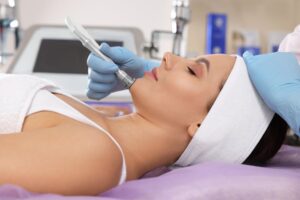Anyone can get embarrassing zits, from teenagers to adults. However, if a person’s complexion is frequently marred by imperfections, they can develop acne. Although acne is not a serious medical issue, it can have a significant negative effect on a person’s social life and self-esteem. It may eventually result in physical scars that is irreversible. Fortunately, acne may be effectively treated and managed. Here is a closer look at some of the potential causes of acne as well as some lifestyle modifications that can result in smoother skin.
Acne: What Is It?
Acne is a common inflammatory skin disorder that develops when sebum (oil), bacteria, and/or dead skin cells clog hair follicles beneath the skin. Pimples, which can appear practically anywhere on the body, including the face, chest, back, neck, and shoulders, are a variety of lesions that can be brought on by this. Blackheads, whiteheads, cysts, and other serious inflammatory lesions are all forms of painful acne that can range in severity.
The hormonal changes associated with puberty cause acne to mostly affect teenagers and young adults. Acne can sometimes strike an adult sufferer for the first time. Some adults may still experience acne long into their 30s, 40s, or even 50s.
Potential Causes of Acne
The origins of acne are the subject of numerous urban legends. For instance, many individuals think that eating fatty, sugary foods like chocolate and fries might cause pimples. Although such statements lack scientific backing, there are some things that can increase your risk of getting acne, such as the following:
- Genetics: Since skin color runs in families, a person is more likely to get acne if either of their parents had the inflammatory skin disorder.
- Hormones: Changing hormone levels are typical during adolescence and pregnancy, which may lead to increased sebum production from oil glands. Breakouts may result from clogged hair follicles caused by excessive oil production.
- Medications: Acne may be brought on by or made worse by some pharmaceutical drugs. Steroids taken orally or intravenously, birth control, and medications containing testosterone and lithium are a few examples.
- Stress: Although stress does not directly cause acne, it can exacerbate already present lesions. Additionally, it could increase the amount of sebum produced by oil glands, leading to clogged pores.
- Cosmetics: Blemishes may be brought on by oily cosmetics and personal care items, such as thick lotions and hair waxes. Use noncomedogenic (non-pore-blocking) products and regularly remove makeup as a result of this.
- Diet: According to several studies, eating some foods may make acne worse. For instance, sugary foods and refined carbs like chips and bread might increase sebum production and aggravate inflammation.
Changes To Make for Clearer Skin
Acne can now be successfully treated thanks to recent dermatological advancements. A dermatologist may recommend topical medications and antibiotics for people with severe acne to lessen outbreaks. A change in lifestyle might also result in cleaner skin.
- Cleanse skin. Skin cleanliness aids in the reduction of microorganisms and oil. After applying makeup and after working out, make sure to cleanse your skin. Instead of vigorously rubbing dry, pat.
- Decrease stress. More sleep helps reduce stress and stop the release of the hormone cortisol, which promotes inflammation. Yoga, meditation, exercise, and journaling are other stress-reduction techniques that can help you avoid breakouts.
- Use sunscreen. Sun protection is essential since it can help prevent additional sun damage, scarring, and discolouration. When taking acne drugs that make the skin more susceptible to sunburn, it’s crucial to wear sunscreen. Use a noncomedogenic product that is oil-free and has an SPF of 30 or higher.
Acne can be excruciatingly annoying and painful, but with the appropriate course of therapy and persistence, it is treatable. See the resource below for more information on the causes and treatment of this common skin ailment.




